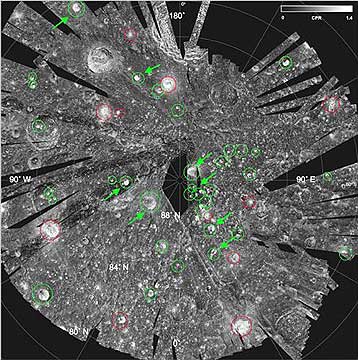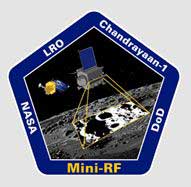
Craters at the north pole of the Moon. *Fresh Craters. *Anomalous Craters.
"The emerging picture from the multiple measurements and resulting data of the instruments on lunar missions indicates that water creation, migration, deposition and retention are occurring on the moon," said Paul Spudis, principal investigator of the Mini-SAR experiment at the Lunar and Planetary Institute in Houston. "The new discoveries show the moon is an even more interesting and attractive scientific, exploration and operational destination than people had previously thought."

The Mini-RF project will fly two radar instruments to the moon to map the lunar poles, search for water ice, and to demonstrate future NASA communication technologies. The first instrument launched on the Indian Space Research Organisation’s (ISRO’s) Chandrayaan-1 spacecraft and will map both polar regions. The second instrument will fly on NASA’s Lunar Reconnaissance Orbiter (LRO) and will perform targeted radar observations and communications demonstrations.
 Chandrayaan-1’s two-year mission is India’s first to the moon. It consists of a lunar orbiter that will map the moon from a 100-kilometer circular polar orbit. It carries 11 instruments, including Mini-SAR. LRO was built at Goddard Space Flight Center in Maryland. It is carrying seven instruments and will map the moon for one year from a 50-kilometer circular polar orbit. It was developed and built by the Naval Air Warfare Center in China Lake, California, and several other commercial and government contributors.
Chandrayaan-1’s two-year mission is India’s first to the moon. It consists of a lunar orbiter that will map the moon from a 100-kilometer circular polar orbit. It carries 11 instruments, including Mini-SAR. LRO was built at Goddard Space Flight Center in Maryland. It is carrying seven instruments and will map the moon for one year from a 50-kilometer circular polar orbit. It was developed and built by the Naval Air Warfare Center in China Lake, California, and several other commercial and government contributors.
"After analyzing the data, our science team determined a strong indication of water ice, a finding which will give future missions a new target to further explore and exploit," said Jason Crusan, program executive for the Mini-RF Program for NASA's Space Operations Mission Directorate in Washington.
The Mini-SAR's findings are being published in the journal Geophysical Research Letters. The results are consistent with recent findings of other NASA instruments and add to the growing scientific understanding of the multiple forms of water found on the moon. The agency's Moon Mineralogy Mapper discovered water molecules in the moon's polar regions, while water vapor was detected by NASA's Lunar Crater Observation and Sensing Satellite, or LCROSS.
For more information about NASA's Mini-SAR, also known as Mini-RF, please visit.

